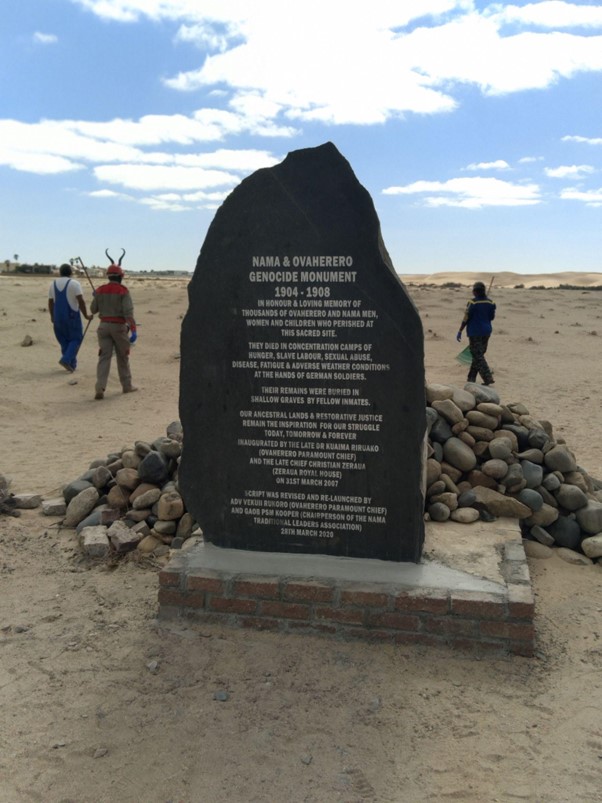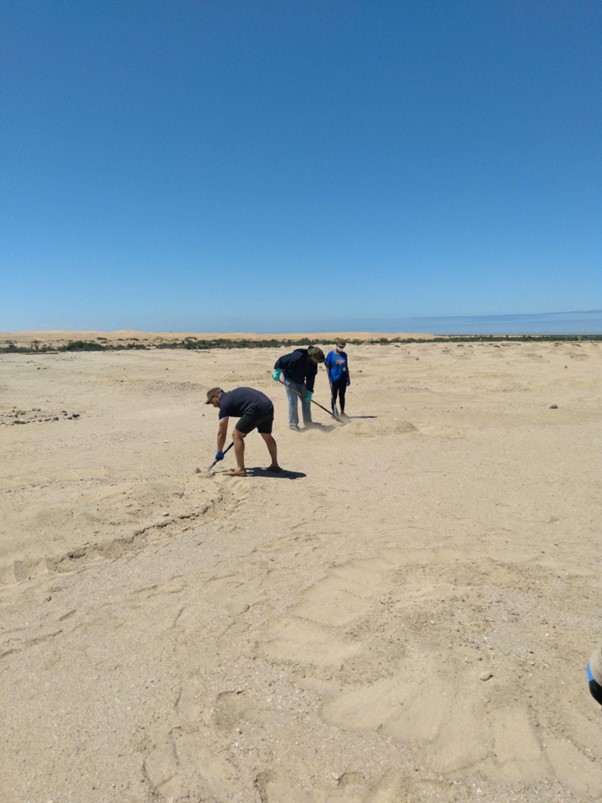“They died for us”: The people tending to the graves of Namibia’s colonial genocide victims
- Between 1904 and 1908, German colonial forces in Namibia launched a crippling attack on the Ovaherero at Ohamakari, resulting in a genocide that claimed the lives of more than 80% of the Ovaherero population and 50% of the Nama population. Buried in unmarked and often neglected graves, a group of young people are now giving these victims long overdue attention.

Corma: We women of Hereroland will always stand behind our warriors and urge them to fight foreign invaders, even those with cannons and machine guns.
German officer: Stop! Where are your men? Running away as fast as they can –
Corma: Yesterday’s battle was disastrous. So many women and children blown to pieces.
German officer: You cannot expect freedom of passage when you stand behind your soldiers
German officer: And you will pay with your lives. For every dead German soldier let there be one hundred dead Hereros.
Corma: Soldier, if I should stop to call you that, your senseless shooting of our women and children with cannons and machine guns cries out for pity –
German officer: This is all out war; a war the Hereros started. In war, the innocent die with the guilty. If you stand behind your warriors and shout “Kill German soldiers”, you may expect no mercy –
Corma: This is our land – the home of our children. We are not armed, nor will we ever be. Your brutality far exceeds the demands of war. Even wild animals in a rage behave better than German soldiers. Justice will one day be done. It will see our families back in Hereroland and you will be gone-
This is an extract from Samuel Maharero, a 2001 play by Clarence Kaakunga on the colonial genocide that took place between 1904 and 1908 in Namibia. In this scene, there is a confrontation between a German colonial soldier and an Ovaherero woman, Corma. The encounter comes as Corma was fleeing with her three children, Kangoo, Kandji and Kangoo across the Omaheke Desert to Botswana to escape the onslaught of the Germans on the Ovaherero. Between 1904 and 1908, the German colonial forces in Namibia – then German South-West Africa – launched a crippling attack on the Ovaherero at Ohamakari. The Nama, who launched a guerrilla offensive against the Germans, were also similarly targeted. This resulted in a genocide that claimed the lives of more than 80% of the Ovaherero population and 50% of the Nama population. It was especially women like Corma and their children that suffered the most from Germany’s colonial genocide in Namibia. Those who were not killed were brutally raped and forced to labour for their German colonial masters in the many concentration camps that were established in southern and central Namibia. Bodies of some of the deceased were taken to Germany for scientific experiments.
Since Namibian independence in 1990, Ovaherero and Nama activists have demanded that the German government pay reparations to them. Twenty-five years later, the Namibian and German governments started negotiations over an apology and reparations for the colonial genocide. In 2021, Germany agreed in principle to apologize and pay 1.1. billion euros for “development projects” in the regions that the Ovaherero and Nama populations historically occupied. The deal was however widely criticized by some Ovaherero and Nama traditional leaders for not including them more prominently in the negotiations.
Although the two groups are unsatisfied with how they have been excluded from the negotiations, they continue to work tirelessly to honour the victims of the colonial genocide and ensure that their story is not forgotten. They have also recently been joined by several other groups comprising younger activists who are also working at illuminating the experiences of the colonial genocide in Namibia. In Swakopmund – Namibia’s coastal town known for its German colonial architecture – a group of activists established the Namibian Genocide Association (NGA) to keep the memories of the colonial genocide alive. The Otjiherero words Katuna Okuzemba Ko, which means “We will not forget” in English is the motto of the association.
“The Namibian Genocide Association mostly has young members. This is because we are not fighting for ourselves. We want the next generation to have a better future,” says Lourens Ndura, the former Secretary-General of the association. “The wounds of the genocide still live with us and [are]passed on from the previous generation. Our children need to start healing from the trauma.”
Laidlaw Peringanda is the current chairperson of the association. He is a descendant of the Ovaherero people and an activist. Since 2018, he and the members of the association have been organising annual cemetery cleanings at the cemetery in Kramersdorf – a former “whites-only” suburb – in Swakopmund. This cemetery was formerly separated into sections for whites and blacks. It is also where many of the Ovaherero and Nama victims of the colonial genocide were buried in unmarked graves.
“We started with the clean-ups at the cemetery because this cemetery contains one of the biggest mass graves from the colonial period in Namibia. We have these clean-ups regularly to preserve the graves,” Peringanda says
According to Lourens Ndura, NGA were motivated to start with the cleanings when they saw how graves belonging to the genocide victims were being neglected by the workers of the Swakopmund Municipality. “These graves have never been given attention,” he says. “The municipal workers there only take care of the graves of the whites, while forgetting about the graves of our ancestors. That is not fair. They should also be taken care of like the other graves.”
The number of people who come to the cemetery varies every year. Sometimes twenty, sometimes more or less. When they arrive at the cemetery, the participants gather at the Genocide Memorial Stone. This is a black marble stone, 2m high in size and cemented into a brick foundation at the entrance of the cemetery. It was erected in 2007 by a group of Swakopmund residents in honour of the genocide victims. On it, a brief history of the genocide is provided. Upon arrival, participants observe a moment of silence and are given a chance to read the text on the stone.
“In honour & loving memory of thousands of Ovaherero and Nama men, women and children who perished at this sacred site. They died in concentration camps of hunger, slave labour, sexual abuse, disease, fatigue & adverse weather conditions at the hands of German soldiers,” reads the beginning of the text on the stone, which then goes on to give more information on the colonial genocide.

After this, the participants are then given either a shovel, rake, or broom and in groups of at least two go about the cemetery, piling sand on some graves, re-marking some and removing overgrown weeds from others.


The participants come from different backgrounds and for different reasons.
“Honestly, I went out of pure curiosity. I wanted to know about what was going on there,” says 29-year-old Buhle Paulina Ndlovu who hails from South Africa. “When I saw the poster announcing the event, I wanted to be part of that. I wanted to know what the state of things [was] and what the purpose of the restoration of the graves was. “There was a sense of reverence. It was weird that in that cemetery with its dark history you don’t feel the weight of immediate death. Instead, what you feel is people’s intention to care. They showed that they cared about their ancestors.” Frowin Becker, a 30-year-old German Namibian, has attended all the clean-ups. Unlike Ndlovu, the cleanings go beyond curiosity for him; they are about his identity and mould his ideologies.
“They certainly helped adjust my perception of Swakopmund and its community. It’s a far more honest presentation. Most incredibly sobering,” says Becker. “I’ve appreciated being exposed to what draws different participants to this particular site. They’ve definitely encouraged me to study my own family’s and community’s history in this country. That in turn continues to inform my ideology. So, the impact has been quite substantial.”

While cleaning, it is very common for the participants to come across previously undiscovered graves and human remains.
Peringanda says that although it can be saddening and shocking to find people’s bones so easily, it is satisfying to be able to give them a proper burial and make sure their graves are marked.
“It is important to show respect to the victims,” he says. “They died for us. It was not only men but women and children who were kept in the concentration camps”
Along with cleaning the graves, the association has also managed to reduce residential development of houses near the cemetery which often led to cropping on some of the graves and stopped tourists and locals driving over the graves with their 4×4 quad bikes.
Ndura says they will do all they can to preserve the graves because not only are they part of their history, but this is the little they can do to honour their ancestors.
“We need to understand our history. It will help the younger generation to know what happened to their elders,” he says.
The association has also started fundraising to be able to improve the conditions of the graves of the genocide victims in the cemetery.
Ndura says that they will pursue justice and healing in any way they can, including cleaning up the graves of their ancestors.
“We do it to keep it as evidence. Otherwise, the wind will blow the graves away. They will disappear. We can’t let that happen. Our ancestors are buried in those graves,” he says.
Edited/Reviewed by Mamaponya Motsai, Caleb Okereke, Cassandra Roxburgh, and Uzoma Ihejirika.
Bayron van Wyk is a 2022 Minority Africa fellow from Namibia. van Wyk’s life journey began in the small town of Rehoboth in southern Namibia where he was born. As a child, he struggled with his sexuality because of the stigma associated with being openly gay. It took him a long while to accept who he was and to be comfortable with his own sexuality. He is a human rights activist, writer and scholar interested in LGBTIQA+, environmental and climate change issues. Currently, van Wyk is studying in Cape Town, South Africa. His work focuses on LGBTIQA+ organizing in Namibia and through his work, he hopes to bring about more social justice for LGBTIQA+ persons living in Namibia.




